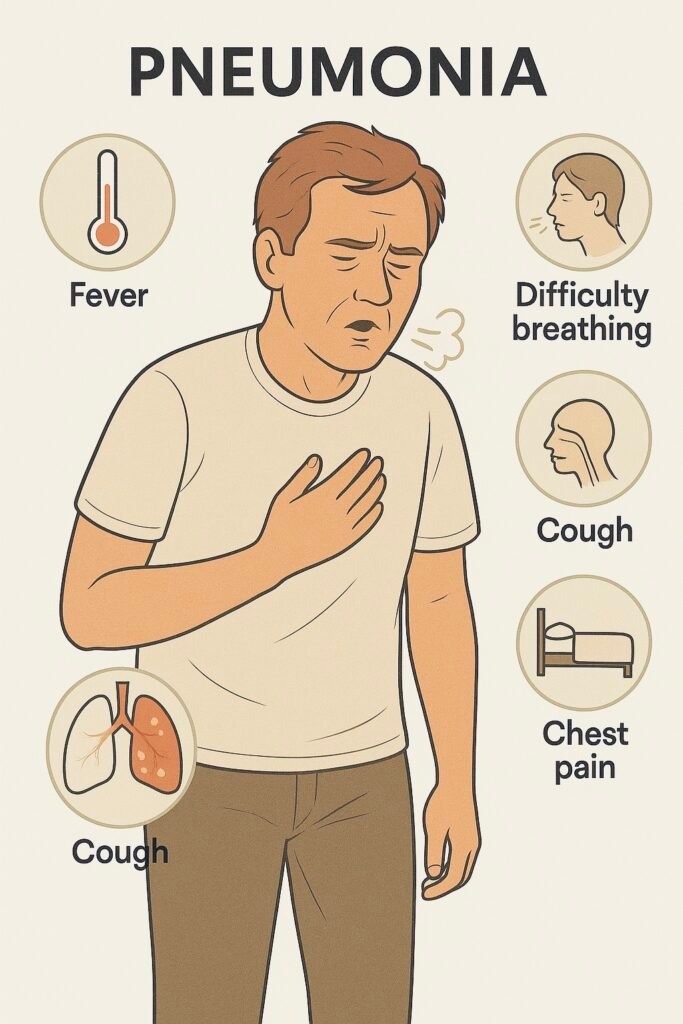5.1. Pneumonia (CAP & HAP)
📄 Definition
Pneumonia is an acute infection of the lung parenchyma causing consolidation, typically with cough, fever, and breathlessness.
Types include:
-
CAP – Community-Acquired Pneumonia
-
HAP – Hospital-Acquired Pneumonia (onset ≥48 hours after admission)
Lobar or Unilateral
New infiltrates on imaging
Green/yellow sputum
Infection signs (fever, ↑CRP)
Neutrophilia
Fatigue
Elevated RR
Confusion (elderly)
Tachycardia
Inspiratory crackles
Overexertion breathlessness
Night sweats ± pleuritic pain
Pathophysiology
Inhalation of microbes (e.g. Streptococcus pneumoniae)
→ alveolar inflammation
→ capillary leak + exudate
→ consolidation and impaired gas exchange

Risk Factors
Mnemonic: SPLASH
Smoking
Pre-existing lung disease (COPD, asthma)
Low immunity (HIV, diabetes, cancer)
Age extremes (elderly, infants)
Steroids or immunosuppressants
Hospitalisation (for HAP)
 Clinical Features
Clinical Features
Mnemonic: COPS
Cough (productive ± blood-streaked)
Over 38°C fever
Pleuritic chest pain
Shortness of breath
Others: rigors, confusion (elderly), fatigue
Diagnosis
CXR = gold standard
FBC: neutrophilia
CRP, U&Es (for CRB65)
Blood cultures (if severe)
Sputum culture ± Legionella/pneumococcal urinary antigens
O₂ sats (ABG if <92%)
CXR Findings
Mnemonic: ABC of Consolidation
Air bronchograms
Bronchial wall thickening
Confluent opacity (lobar or patchy)
Lobar: homogeneous, sharp borders
Bronchopneumonia: multifocal, patchy
Aspiration: often lower zone, right lung
Severity Assessment – CRB65 Score (NICE)
Mnemonic: CRB65
Confusion (AMTS ≤8)
Respiratory rate ≥30
Blood pressure (SBP <90 or DBP ≤60)
65 years or older
| Score | Risk | Action |
|---|---|---|
| 0 | Low | Home treatment ± PO antibiotics |
| 1–2 | Moderate | Hospital referral |
| ≥3 | High | Urgent hospital admission ± ITU review |
Management
➤ CAP
Mnemonic: CAP DOC
CURB65 score guides location of care
Amoxicillin 500 mg TDS 5 days (mild)
Penicillin allergy → doxycycline or clarithromycin
Dual therapy (amoxicillin + macrolide) if moderate/severe
Oxygen + fluids if needed
CXR repeat in 6 weeks if red flags (e.g. smoker, >50yrs)
➤ HAP
Within 5 days: cover Gram-positive + typicals
After 5 days: cover Gram-negative + resistant bugs
e.g. co-amoxiclav or piperacillin-tazobactam
Monitoring & Follow-Up
O₂ sats, RR, temp, HR
Check CRP, WCC, and U&Es
Repeat CXR after 6 weeks if:
smoker
>50 yrs
slow resolution
lobar consolidation
Complications
Mnemonic: LIES
Lung abscess
Infection spread (empyema, sepsis)
Effusion (parapneumonic or empyema)
Scarred lung (fibrosis, bronchiectasis)
Differential Diagnoses
Mnemonic: PALM PECS
Pulmonary embolism
Asthma/COPD exacerbation
Lung cancer
Myocardial infarction
Pleural effusion
Eosinophilic pneumonia
COVID-19
Sarcoidosis
Last updated in line with NICE NG138 (October 2019)
Reviewed for PassMap: 14 July 2025
This content is NICE-compliant and exam-optimised for the Physician Associate Regulation Assessment (PARA).
